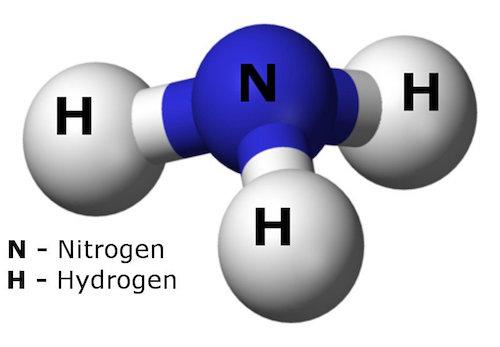Ammonia - Facts

What is ammonia?
Ammonia (NH3) is one of the most commonly produced industrial chemicals in the United States. It is used in industry and commerce, and also exists naturally in humans and in the environment. Ammonia is essential for many biological processes and serves as a precursor for amino acid and nucleotide synthesis. In the environment, ammonia is part of the nitrogen cycle and is produced in soil from bacterial processes. Ammonia is also produced naturally from decomposition of organic matter, including plants, animals and animal wastes.
Some chemical/physical properties of ammonia are:
- At room temperature, ammonia is a colorless, highly irritating gas with a pungent, suffocating odor.
- In pure form, it is known as anhydrous ammonia and is hygroscopic (readily absorbs moisture).
- Ammonia has alkaline properties and is corrosive.
- Ammonia gas dissolves easily in water to form ammonium hydroxide, a caustic solution and weak base.
- Ammonia gas is easily compressed and forms a clear liquid under pressure.
- Ammonia is usually shipped as a compressed liquid in steel containers.
- Ammonia is not highly flammable, but containers of ammonia may explode when exposed to high heat.
How is ammonia used?
About 80% of the ammonia produced by industry is used in agriculture as fertilizer. Ammonia is also used as a refrigerant gas, for purification of water supplies, and in the manufacture of plastics, explosives, textiles, pesticides, dyes and other chemicals. It is found in many household and industrial-strength cleaning solutions. Household ammonia cleaning solutions are manufactured by adding ammonia gas to water and can be between 5 and 10% ammonia. Ammonia solutions for industrial use may be concentrations of 25% or higher and are corrosive.
How can people be exposed to ammonia?
Most people are exposed to ammonia from inhalation of the gas or vapors. Since ammonia exists naturally and is also present in cleaning products, exposure may occur from these sources. The widespread use of ammonia on farms and in industrial and commercial locations also means that exposure can occur from an accidental release or from a deliberate terrorist attack.
Anhydrous ammonia gas is lighter than air and will rise, so that generally it dissipates and does not settle in low-lying areas. However, in the presence of moisture (such as high relative humidity), the liquefied anhydrous ammonia gas forms vapors that are heavier than air. These vapors may spread along the ground or into low-lying areas with poor airflow where people may become exposed.
What is ammonia’s mechanism of action?
Ammonia interacts immediately upon contact with available moisture in the skin, eyes, oral cavity, respiratory tract, and particularly mucous surfaces to form the very caustic ammonium hydroxide. Ammonium hydroxide causes the necrosis of tissues through disruption of cell membrane lipids (saponification) leading to cellular destruction. As cell proteins break down, water is extracted, resulting in an inflammatory response that causes further damage.
What are the immediate health effects of ammonia exposure?
Inhalation: Ammonia is irritating and corrosive. Exposure to high concentrations of ammonia in air causes immediate burning of the nose, throat and respiratory tract. This can cause bronchiolar and alveolar edema, and airway destruction resulting in respiratory distress or failure. Inhalation of lower concentrations can cause coughing, and nose and throat irritation. Ammonia's odor provides adequate early warning of its presence, but ammonia also causes olfactory fatigue or adaptation, reducing awareness of one's prolonged exposure at low concentrations.
Children exposed to the same concentrations of ammonia vapor as adults may receive a larger dose because they have greater lung surface area-to-body weight ratios and increased minute volumes-to-weight ratios. In addition, they may be exposed to higher concentrations than adults in the same location because of their shorter height and the higher concentrations of ammonia vapor initially found near the ground.
Skin or eye contact: Exposure to low concentrations of ammonia in air or solution may produce rapid skin or eye irritation. Higher concentrations of ammonia may cause severe injury and burns. Contact with concentrated ammonia solutions such as industrial cleaners may cause corrosive injury including skin burns, permanent eye damage or blindness. The full extent of eye injury may not be apparent for up to a week after the exposure. Contact with liquefied ammonia can also cause frostbite injury.
Ingestion: Exposure to high concentrations of ammonia from swallowing ammonia solution results in corrosive damage to the mouth, throat and stomach. Ingestion of ammonia does not normally result in systemic poisoning.
How is ammonia exposure treated?
There is no antidote for ammonia poisoning, but ammonia's effects can be treated, and most people recover. Immediate decontamination of skin and eyes with copious amounts of water is very important. Treatment consists of supportive measures and can include administration of humidified oxygen, bronchodilators and airway management. Ingested ammonia is diluted with milk or water.
Will laboratory tests assist in making treatment decisions if someone has been exposed to ammonia?
Laboratory testing for ammonia exposure will not be useful in making emergency treatment decisions. Medical tests that can detect ammonia in blood or urine are available. However, because ammonia is normally found in the body, these test results cannot serve as biomarkers of exposure. After exposure to low levels, ammonia is either rapidly cleared from the body or metabolized to compounds found endogenously at appreciable levels. Clinical indices of body ammonia or nitrogen levels after exposure to exogenous ammonia have shown no or minimal change from prior levels. Exposure to high concentrations is immediately and overtly toxic, generally providing an adequate basis for diagnosis.
How can I get more information about ammonia?
Call the following numbers, or visit the websites listed among the "Sources."
- Centers for Disease Control and Prevention Public Response Hotline (1-888-246-2675)
- Agency for Toxic Substances and Disease Registry (1-888-422-8737)
- Regional Poison Control Center (1-800-222-1222)
Source: https://www.health.ny.gov